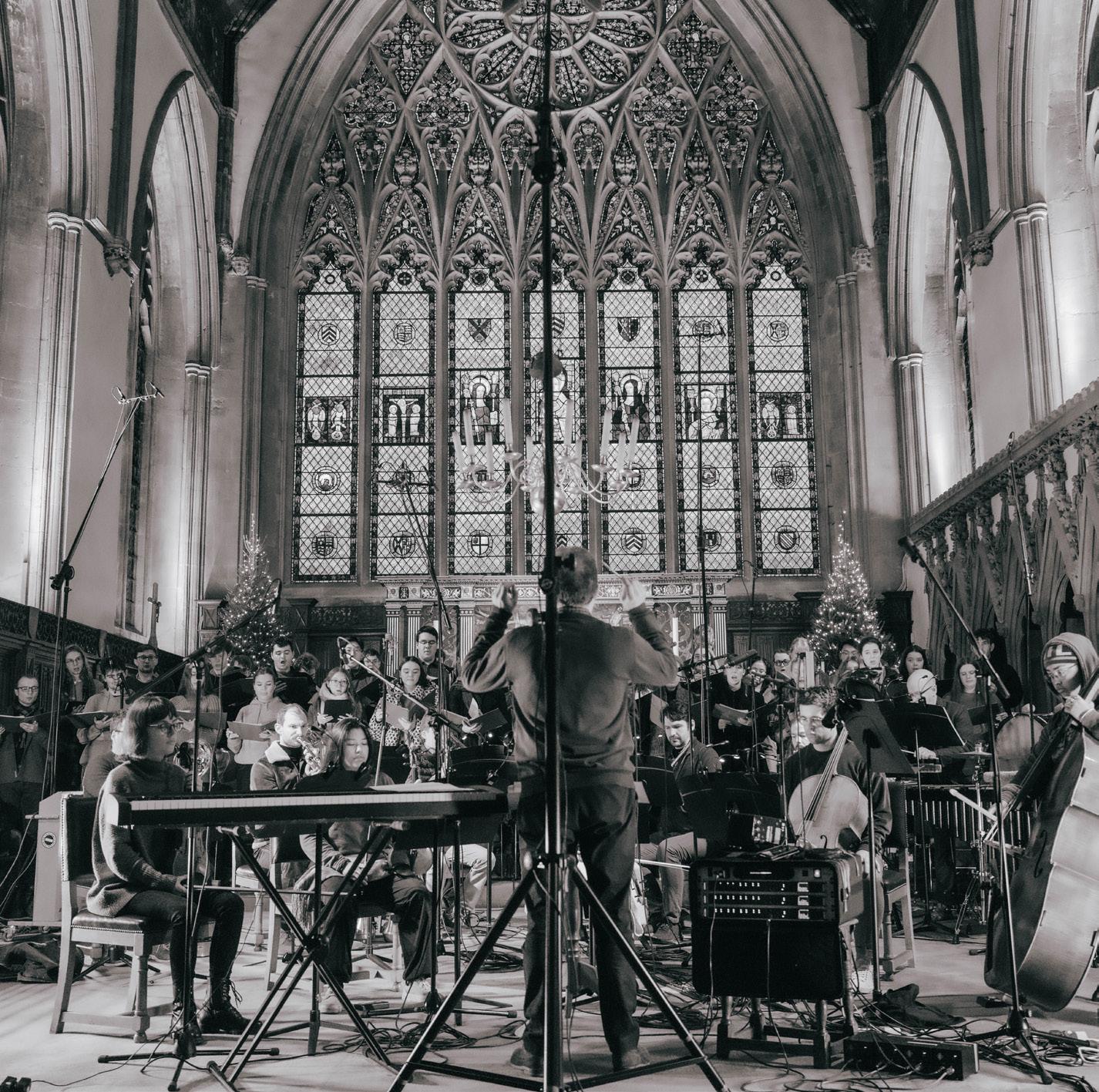GABRIEL JACKSON THE CHRISTMAS STORY
CHOIR OF MERTON COLLEGE, OXFORD THE GIRL CHORISTERS OF MERTON COLLEGE, OXFORD OXFORD CONTEMPORARY SINFONIA BENJAMIN NICHOLAS

GABRIEL JACKSON THE CHRISTMAS STORY
CHOIR OF MERTON COLLEGE, OXFORD THE GIRL CHORISTERS OF MERTON COLLEGE, OXFORD OXFORD CONTEMPORARY SINFONIA BENJAMIN NICHOLAS
1 Conditor alme siderum ae [2:13]
EPIPHANY
11 Tribus miraculis ornatum ae [3:02]
2 I look from afar ae Oscar Tovey Garcia tenor, Verity Sawbridge soprano [6:55]
3 Expecting bd [4:48]
4 Sit Christe rex ae [2:25]
Choir of Merton College, Oxford a
The Girl Choristers of Merton College, Oxford b Owen Chan organ c
François Cloete organ d
Oxford Contemporary Sinfonia e Benjamin Nicholas conductor (b. 1962)
5 Veni redemptor gentium ae [2:15]
6 And it came to pass in those days ae [2:08]
7 Lullaby of the Beasts bc [3:29]
8 And there were in the same country ae [3:44]
9 O magnum mysterium ae [4:56] 10 Toccata c [1:16]
12 Now when Jesus was born in Bethlehem ae
Oscar Tovey Garcia tenor, Edward Chesterman & Alexander Smith basses; Harry Street alto [3:36]
13 Wie schön leuchtet der Morgenstern ae [0:35]
14 And the third day there was a marriage ae
Olivia Earl alto, Edward Chesterman bass [2:48]
15 A Guest at Cana bd [4:16]
16 And it came to pass in those days ae
Olivia Earl alto, Oscar Tovey Garcia tenor, Hugo Till bass [1:34]
17 Benedicite omnia opera ae [2:27]
18 Lumen ad revelationem gentium ae [1:39]
19 When the days of Mary’s purification ae [3:24]
20 Nunc dimittis servum tuum ae [1:59]
21 Joseph and his mother ae Edward Chesterman bass [1:32]
22 Lumen ad revelationem gentium ae [0:51]
23 And there was one Anna ae [1:06]
24 Anna’s Song bc [3:48]
25 And when they had performed all things ae [1:08]
O nata lux de lumine abde [5:35]
playing time [73:41]
Recorded on 11-12 December 2023 in the Chapel of Merton College, Oxford
Producer/Engineer: Paul Baxter
24-bit digital editing: Jack Davis
24-bit digital mixing & mastering: Paul Baxter
Session photography: Will CoatesGibson / foxbrushfilms.com
Design: John Christ
Booklet editor: John Fallas
Delphian Records Ltd – Edinburgh – UK www.delphianrecords.com
With thanks to the Warden and Fellows of the House of Scholars of Merton College, Oxford
@ delphianrecords @ delphian_records
@ delphianrecords
Delphian Records and the Choir of Merton College, Oxford gratefully acknowledge the generosity of Reed Rubin and The Reed Foundation in making this recording possible.
The theological rationale behind the compilation of texts for The Christmas Story is the same as for Gabriel Jackson’s The Passion of our Lord Jesus Christ (commissioned by Merton College in 2014 to mark the College’s 750th anniversary). Both the birth and the death of Christ happened at a particular time and in a particular place. For Christians, however, their particularity is mirrored by an eternal and universal significance, touching every time and every place. The libretto for The Christmas Story attempts to capture this dual perspective.
In relation to the local, just as the text for the Passion located the narrative of humanity’s redemption within the history of Merton College, Oxford, so too its Christmas counterpart is rooted in the College. This is expressed by its use of the King James Version of the Bible, part of which was translated at Merton, and of specially commissioned poems by two contemporary Merton poets. Penny Boxall was a Visiting Research Fellow in the Creative Arts at Merton in 2019. Mary Anne Clark joined the College in 2014 to read English, and went on to complete a doctorate on rhyme in Shakespeare’s theatre.
Like the Passion, The Christmas Story is deeply liturgical. Its four scenes reflect the four principal seasons and feasts within the Christmas cycle – Advent, Christmas,
Epiphany and Candlemas. Each section begins and ends with a liturgical text sung in Latin. Advent is bookended by the first and final verses of one of the office hymns for the season. The opening verse is followed by biblical texts which give voice to three of the forerunners of Christ’s birth: the prophet Isaiah, John the Baptist and Mary’s cousin, Elizabeth. Each text is in dialogue with words from the Advent Matins responsory. Elizabeth’s words to her cousin, ‘Blessed art thou among women, and blessed is the fruit of thy womb’, segue into Penny Boxall’s interpretation of the wonderings of the pregnant Mary in her poem ‘Expecting’.
Christmas begins with the first verse of one of the feast’s office hymns, which leads into short texts from Luke’s Gospel, highlighting three details from the Lukan birth narrative: Caesar’s decree that all should go to their home town to be taxed, the journey of Joseph and Mary to Bethlehem, and the birth of Christ itself. The response to the birth is a lullaby, though in Mary Anne Clark’s poem it is sung to the newborn by the beasts gathered around the manger, rather than by Mary or Joseph. Luke’s account of the night-time appearance of the angels and of the shepherds’ visit to the Christ-child leads into the Matins responsory for Christmas, in which the birth of Christ is given theological significance as a great mystery and wonderful sacrament.
The visit of the Magi is only one of the events traditionally celebrated at Epiphany. As the Magnificat antiphon that opens this scene describes, the miracle at Cana and the baptism of Christ also reveal Christ’s identity. Matthew’s account of the Magi is followed by the first verse of ‘Wie schön leuchtet der Morgenstern’, a hymn written by the Lutheran pastor Philipp Nicolai in 1597. Penny Boxall reflects on John’s telling of the wedding at Cana, describing astonishment at the revelation of the extraordinary in the everyday. Following the chronology of the opening antiphon, this scene concludes with the very brief description of the baptism of Christ in Mark’s Gospel, followed by verses from the canticle ‘Benedicite omnia opera’, from the Apocrypha’s Song of the Three Children, which articulates the praise of all creation in response to the Christ who, in the River Jordan, is revealed as God’s beloved Son.
The feast of Candlemas, commemorating Christ’s presentation in the Temple forty days after his birth, completes the Christmas story. Simeon’s song, the canticle ‘Nunc dimittis’, plays a key role in the Candlemas liturgy. Here it is given prominence within Luke’s account of the Presentation by being set in Latin, with its final verses, often sung as an antiphon when it is performed liturgically to accompany a procession, framing this scene in the temple. The prophetess Anna also encounters Jesus,
but her part in the narrative is often overlooked. Here Mary Anne Clark gives her a voice and a song. Though Candlemas is a bittersweet commemoration, Simeon’s haunting prophecy that, at a future time, a sword will pierce Mary’s heart does not eclipse Anna’s faith that, in Christ, ‘the future has come to life’ and therefore ‘the temple throws open its doors, to let the light come in’. And so the scene concludes with verses from an office hymn for the feast of the Transfiguration, in praise of Jesus, the light of the world.
© 2024 Simon Jones
The Very Revd Dr Simon Jones compiled the libretto of The Christmas Story. He was Chaplain and Fellow of Merton College, Oxford from 2002 to 2024, and in September 2024 was installed as Dean of Lincoln..
Like the ancient Roman God who faced both backwards and forwards, music – perhaps uniquely amongst the fine arts – has a Januslike capacity to look simultaneously at the future and the past. The creative tension which this causes has been a source of innovation in Western music since the disputations about ars nova and ars antiqua which were argued in the late medieval period, the controversies concerning stile antico and stile moderno which erupted in the 1600s, and right up to our own times, with Igor Stravinsky perhaps the best-known example of a composer renewing the musical language of the present by embracing that of the past.
In the case of The Christmas Story, Gabriel Jackson tips his cap to the work of his seventeenth-century forebears before we have even heard a note of music: the very title of his piece pays homage to Heinrich Schütz’s Weihnachtshistorie. Indeed, says the composer, the piece attempts in part to reimagine the sound-world of the early Baroque. The instrumentation combines wind, brass and stringed instruments in ways which conjure up the rich sonorities of seventeenthcentury Germany and Italy (and sometimes a lean, rather Stravinskian sound-world). Prominent amongst the instrumental forces are three trombones (included at the particular request of the conductor Benjamin Nicholas), whose plangent and baleful sonorities, coupled
to long historical associations with the spiritual (the music of funerals) and the supernatural (from Monteverdi’s Orfeo via Mozart’s Don Giovanni and even up to Gilbert and Sullivan’s Ruddigore, to take just three examples), bring
what the composer himself describes as an always hieratic presence to the music.
Other important elements of the work’s soundworld come from percussion (often pitched – the vibraphone has a prominent role), alto saxophone (an instrument Jackson describes as ‘simultaneously ultra-modern and somehow primordial’), as well as flute, string quintet and, in certain strategically defined parts of the work, church organ. All are employed not just for colour but also illustrative effect – sometimes in ways which are avowedly pictorial: when the angel appears on the Bethlehem hillside, for example, vibraphone roulades create a halo-like effect; and the shepherds arrive at the manger in a procession of pipes and fiddles.
The four-part span of the work (structured through the libretto devised by the Reverend Dr Simon Jones) begins of course in the season of Advent, with the prophecies foretelling the coming of Christ, and ends with the final celebration of the Christmas season, the Feast of the Purification. Scriptural and liturgical texts, in both English and Latin, advance the narrative as well as providing moments for reflection within it, and are complemented by
four specially written poems, giving a broadly symmetrical structure to each of the four parts. The effect is of a series of tableaux (Simon Jones calls them ‘scenes’), but within this plan are several sub-structures, such as the series of set-piece Latin motets which punctuate the work or the sequence of carols for organ and treble voices (Merton’s young girl choristers, who are positioned at a distance from the rest of the performers throughout the work until they process in at the end to sing together at last in the same space). Each of the four parts, too, is introduced by, in turn, a solo brass, percussion, string and woodwind instrument.
The setting of the text is varied and may sometimes appear counterintuitive. Just as, in the Passion settings of the fifteenth and sixteenth centuries, the same protagonist may be represented not by an individual singer but by different combinations of voices, here a single character may be represented equally by a solo singer or by a part of the choir (tenors for the angel of the Lord, basses for John the Baptist, tenors and basses together for the shepherds or for the governor at the feast). The cross-cutting and dramatic juxtapositions which this creates are almost cinematic in effect, and are a feature also of Jackson’s previous large-scale work for Merton, The Passion of our Lord Jesus Christ. Word-setting is often syllabic and pacey, meaning that repetition and amplification,
when they do occur, assume great dramatic significance and power. And in a work spanning the long period from Advent to Candlemas –together with modes, levels and hierarchies of language which include poetry, prose, Latin, German, and English both ancient and modern – there is much text to be set.
Advent centres on John the Baptist in the wilderness, enjoining us to prepare for the coming of Christ. The commanding trombone fanfare of the opening bars evokes that voice before the choir sings the Latin hymn ‘Conditor alme siderum’, addressing Christ and the Creator God. A plangent saxophone solo – keening, wailing, crying for attention –introduces words of prophecy from both the Book of Isaiah and the Gospel of St Luke and leads to the first of the carols for treble voices. Here, Penny Boxall’s words become a faltering dance in which the Virgin Mary meditates on the hardships of pregnancy and ponders the mysteries to come: ‘wondering, wondering, wondering about you’. The tableau concludes with a further verse of the opening Latin hymn.
In the second tableau we reach the Christmas season proper. The opening hymn greets the Redeemer, welcoming Him to the world. For the familiar account of the Nativity story, as recounted by St Luke, the text is dispatched in quite matter-of-fact choral recitative (a technique familiar to composers of the early Baroque).
But the pace of the narrative slows when the Virgin tenderly lays the newborn child in the manger – her awe signified by longer notes, followed by a tiny reflective passage for the strings. In the second carol for trebles, Mary Anne Clark imagines the stable animals gazing at the newborn infant, accompanied by a pipe tune played on the organ’s clarinet stop.
We move next to the hillside, where garlands of vibraphone notes evoke the unearthly atmosphere as the angel commands the shepherds to go into Bethlehem and see the child, their arrival accompanied by rustic fiddles and drones. Concluding this second tableau, the Christmas responsory ‘O magnum mysterium’ conjures up the ineffable mystery of the scene, with the choir again accompanied by vibraphone, otherworldly and luminous. A brilliant organ toccata adds a note of jubilation.
The Feast of the Epiphany marks the moment in the Christmas story when the newborn child is revealed to the world, symbolised by the arrival of the three travellers, or wise men, who have followed the star in order to see and bear witness to the miraculous birth. This third part of the work begins with the antiphon ‘Tribus miraculis ornatum’, and ends with a setting of lines from the Benedicite which uses the same music as the antiphon, now overlaid with instrumental material for saxophone and trombones.
Introduced by a hushed viola solo, the antiphon text links the arrival of the wise men to other earthly signs of Christ’s divinity – His first miracle at the Cana wedding feast, and His baptism in the River Jordan. Settings of ‘Tribus miraculis ornatum’ are rare in the liturgical repertoire, and it was at Benjamin Nicholas’s request that Jackson set this section of the libretto a cappella , thus making it available for independent performance outside the context of The Christmas Story.
The ensuing scriptural account, from St Matthew’s Gospel, includes the wise men’s visit to King Herod, who is deeply troubled by their search for a child which must represent a threat to his earthly rule. Here, the protagonists are represented by solo rather than choral voices – a trio of tenors and basses for the wise men, while Herod is cast as a solo countertenor, accompanied by saxophone, flute and agitated string tremolandos. Again, the forward pace of the narrative is suspended when the wise men finally enter the Bethlehem stable: the music becomes reverential and thoughtful as they worship the infant and present their gifts. This moment of wonderment is followed by Jackson’s setting of the Lutheran hymn text ‘Wie schön leuchtet der Morgenstern’, in which jubilant sopranos and altos are accompanied by glockenspiel.
At Cana, an inebriated dance featuring flute, violin and tambourine signals that the wedding feast is well underway. More single-voice characterisation occurs when Mary (a solo alto) tells Jesus (a solo bass) that the wine has nearly all been drunk. Jesus commands six stone pots to be filled with water and carried to the butler, whereupon it is discovered that the well water has been transformed into the finest wine. In the carol for the girl choristers that follows, Penny Boxall describes the miracle as seen by a wedding guest: the party’s hive-like hum, the astonished reaction of the butler, and then the guests’ growing realisation that something deeply mysterious and unfathomable has occurred.
In St Mark’s account of Christ’s baptism in the Jordan, set as a recitative for altos, strings and solo flute, the Holy Spirit – voiced by three soloists at once (alto, tenor and bass) – descends like a dove and God blesses His beloved son. To conclude the third part, words from the Benedicite call upon all creation to bless, magnify and praise the Lord. The alto saxophone and trombones which accompany the choir here evoke a Renaissance cornet and sackbut ensemble.
The fourth and final part draws us likewise into the concluding feast of the Christmas season: Candlemas, or the Presentation of the infant Christ in the Temple. After a pensive
flute opening come words from the Latin song of Simeon, the old man promised by God that he will not die until he has held the boy in his arms. This text – ‘Nunc dimittis servum tuum’, or its final lines used as an antiphon in the liturgy of Candlemas – punctuates Luke’s description of the scene at the Temple: the sacrifice made, according to Jewish law, by Mary and Joseph; Simeon embracing the child and prophesying; Anna giving thanks. Anna is Simeon’s 84-year-old widowed counterpart who, Luke tells us, likewise worshipped at the Temple night and day – fasting, praying and foretelling the coming of the Messiah. Hers is a voice less frequently heard, but an important counterpart to that of Simeon, and she is given special prominence in the libretto of The Christmas Story. In the final treble carol Mary Anne Clark takes Anna’s part, imagining her longed-for and uncontainable joy as she sees that, at last, ‘the future has come to life’. The fourth part draws to a close as the choir tell, in simple terms, of the Holy Family’s return to Nazareth, where the Christ-child grows in strength and wisdom.
While the Christmas story may now have ended, The Christmas Story has not. There follows a setting of the Latin hymn ‘O nata lux de lumine’ – a prayer to Christ as light of the world. Mystical, growing out of silence, it sounds as if it must be derived from timeless plainsong (although it is, in fact,
entirely Jackson’s own creation). Sung first by the treble choir in procession, it is taken up by the instruments and then by the main choir, gaining gradually in strength and power until a threefold statement – in which all the singers and players take part, accompanied by the joyful pealing of bells – seems as if it must be the conclusion of the piece.
However, joy does not quite have the last word. A tiny, thoughtful peroration adds a questioning note to everything we have heard before; the joy of the Nativity, we are reminded, is not the end of the story but only its beginning. Christ’s Passion, Crucifixion and death must follow, before the ultimate triumph of the Resurrection.
Michael Emery is Artistic Director of the professional choirs of Danish Radio in Copenhagen, and a former organ scholar of Merton College.
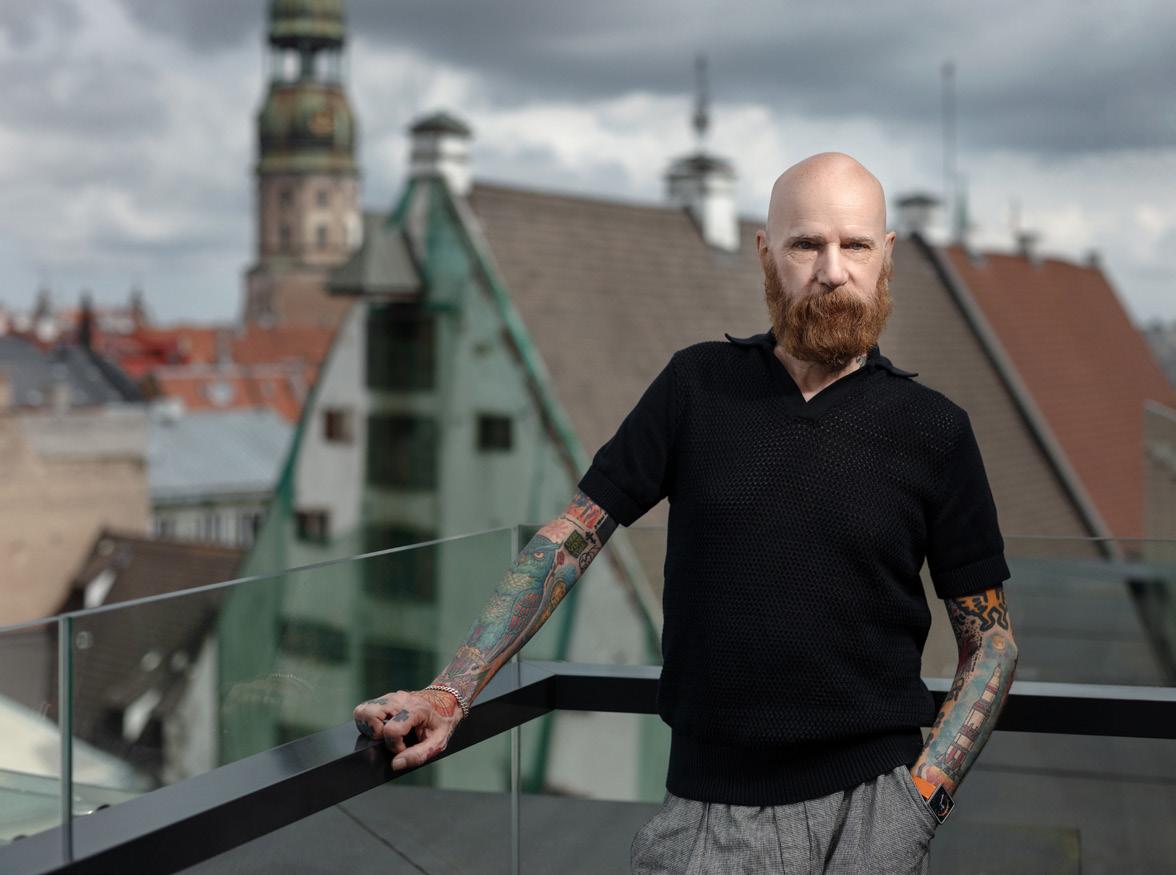
1 Conditor alme siderum aeterna lux credentium Christe redemptor omnium exaudi preces supplicum.
Advent Office Hymn Kind creator of the stars, your believers’ everlasting light, Christ, redeemer of all, hear the prayers of your suppliants.
2 I look from afar: and lo, I see the power of God coming, and a cloud covering the whole earth.
The voice of him that crieth in the wilderness, Prepare ye the way of the Lord, make straight in the desert a highway for our God. Every valley shall be exalted, and every mountain and hill shall be made low: and the crooked shall be made straight, and the rough places plain: And the glory of the Lord shall be revealed, and all flesh shall see it together: for the mouth of the Lord hath spoken it.
Isaiah 40: 3-5
Go ye out to meet him and say:
‘Tell us, art thou he that should come to reign over thy people Israel?’
As the people were in expectation, and all men mused in their hearts of John, whether he were the Christ, or not; John answered, saying unto them all, I indeed baptize you with water; but one mightier than I cometh, the latchet of whose shoes I am not worthy to unloose: he shall baptize you with the Holy Ghost and with fire.
Luke 3: 15-16
High and low, rich and poor, one with another, Go ye out to meet him and say ‘Hear, O thou Shepherd of Israel, thou that leadest Joseph like a sheep, Tell us, art thou he that should come?’
And it came to pass, that, when Elisabeth heard the salutation of Mary, the babe leaped in her womb; and Elisabeth was filled with the Holy Ghost: And she spake out with a loud voice, and said, Blessed art thou among women, and blessed is the fruit of thy womb.
Luke 1: 41-42
Stir up thy strength, O Lord, and come to reign over thy people Israel.
Advent Matins Responsory
3 Expecting
What’s to come I hardly know. I find what certainties I can. So: daily rounds; my body like a loaf; my aching feet, my growing love; the greater weight, the waiting. Our connected heartbeats, leaping.
Always the surety of weather rolls from the north, an enormous call. Night’s a blanket comforting the ground. Every day’s an answer. The tilt, soon now, from woman into mother — though what’s to come I hardly know.
I consider: my hands, if they’re still mine or already my child’s. What happens to time. What’s happening to us. Pondering whether I can bend today to tie my shoe.
I don’t know what’s to come, except wondering, wondering, wondering about you.
Penny Boxall (b. 1987)
4 Sit Christe rex piissime tibi Patrique gloria cum Spiritu Paraclito in sempiterna saecula. Amen.
Advent Office Hymn
Glory be, Christ our most loving king, to you and to the Father, with the Spirit, the Paraclete, for ages everlasting. Amen.
5 Veni redemptor gentium; ostende partum Virginis miretur omne saeculum talis decet partus Deum.
Christmas Office Hymn
Come, redeemer of the nations, and show us your virgin birth: let every age be amazed: such a birth befits a God.
6 And it came to pass in those days, that there went out a decree from Caesar Augustus that all the world should be taxed.
Luke 2: 1
And all went to be taxed, every one into his own city. And Joseph also went up from Galilee, out of the city of Nazareth, into Judaea, unto the city of David, which is called Bethlehem; To be taxed with Mary his espoused wife, being great with child.
Luke 2: 3-4a, 5
And so it was, that, while they were there, the days were accomplished that she should be delivered. And she brought forth her firstborn son, and wrapped him in swaddling clothes, and laid him in a manger; because there was no room for them in the inn.
Luke 2: 6-7
7 Lullaby of the Beasts
Tomorrow is a working day, In milk and wool and strength to pay
With cart and yoke on road and field
For master, market, crop, and yield.
But tonight
The bit and plough Are put away
So by starlight
Safe with us now Lullay lullay lullay.
As fresh as eggs, as warm as hay, As hungry as a lamb in May, Beside our tiredness and our fear
This hatchling God takes shelter here. And tonight
The bit and plough Are put away
So by starlight
Safe with us now Lullay lullay lullay.
For all who know the rider’s goad; For all who feel the heavy load: He came to us – magnificat –
He came to us – remember that.
So tonight
The bit and plough Are put away And by starlight Safe with us now Lullay lullay lullay.
Mary Anne Clark (b. 1995)
8 And there were in the same country shepherds abiding in the field, keeping watch over their flock by night.
And, lo, the angel of the Lord came upon them, and the glory of the Lord shone round about them: and they were sore afraid.
And the angel said unto them,
Fear not: for, behold, I bring you good tidings of great joy, which shall be to all people.
For unto you is born this day in the city of David a Saviour, which is Christ the Lord.
And this shall be a sign unto you;
Ye shall find the babe wrapped in swaddling clothes, lying in a manger. And suddenly there was with the angel a multitude of the heavenly host praising God, and saying, Glory to God in the highest, and on earth peace, good will toward men.
And it came to pass, as the angels were gone away from them into heaven, the shepherds said one to another,
Let us now go even unto Bethlehem, and see this thing which is come to pass, which the Lord hath made known unto us.
And they came with haste, and found Mary, and Joseph, and the babe lying in a manger.
Luke 2: 8-16
9 O magnum mysterium et admirabile sacramentum ut animalia viderent Dominum natum iacentem in praesepio! Beata Virgo cuius viscera meruerunt portare Dominum Christum. Alleluia.
Christmas Matins Responsory
11 Tribus miraculis ornatum diem sanctum colimus: hodie stella magos duxit ad praesepium: hodie vinum ex aqua factum est ad nuptias: hodie in Jordane a Joanne Christus baptizari voluit ut salvaret nos. Alleluia. Magnificat Antiphon, Second Vespers of the Epiphany
O great mystery and wonderful sacrament, that the animals beheld the newborn Lord lying in the crib!
Blessed Virgin, whose womb was worthy to carry the Lord Christ. Alleluia!
We celebrate a holy day adorned with three miracles: today a star led the wise men to the manger; today wine was made from water at the marriage feast; today in the Jordan Christ’s will was to be baptized by John in order to save us. Alleluia.
12 Now when Jesus was born in Bethlehem of Judaea behold, there came wise men from the east to Jerusalem, Saying, Where is he that is born King of the Jews? for we have seen his star in the east, and are come to worship him. When Herod the king had heard these things, he was troubled, and all Jerusalem with him.
And when he had gathered all the chief priests and scribes of the people together, he demanded of them where Christ should be born. And they said unto him, In Bethlehem of Judaea.
Then Herod, when he had privily called the wise men, enquired of them diligently what time the star appeared. And he sent them to Bethlehem, and said, Go and search diligently for the young child; and when ye have found him, bring me word again, that I may come and worship him also.
When they had heard the king, they departed; and, lo, the star, which they saw in the east, went before them, till it came and stood over where the young child was.
When they saw the star, they rejoiced with exceeding great joy. And when they were come into the house, they saw the young child with Mary his mother, and fell down, and worshipped him:
and when they had opened their treasures, they presented unto him gifts; gold, and frankincense and myrrh.
Matthew 2: 1a, 1c-5a, 7-11
13 Wie schön leuchtet der Morgenstern, voll Gnad und Wahrheit von dem Herrn, die süße Wurzel Jesse!
Du Sohn Davids aus Jakobs Stamm, mein König und mein Bräutigam, hast mir mein Herz besessen: lieblich, freundlich, schön und herrlich, groß und ehrlich, reich von Gaben, hoch und sehr prächtig erhaben.
Philipp Nicolai (1556–1608)
How lovely shines the morning star, full of grace and truth from the Lord, the sweet root of Jesse!
O David’s son of Jacob’s line, my king and bridegroom, you have taken possession of my heart: loving, kind, beautiful and lordly, grand and true, rich in gifts, highly and splendidly exalted.
14 And the third day there was a marriage in Cana of Galilee; and the mother of Jesus was there:
And both Jesus was called, and his disciples, to the marriage.
And when they wanted wine, the mother of Jesus saith unto him, They have no wine.
Jesus saith unto her, Woman, what have I to do with thee?
mine hour is not yet come.
His mother saith unto the servants, Whatsoever he saith unto you, do it.
And there were set there six waterpots of stone.
Jesus saith unto them, Fill the waterpots with water.
Draw out now, and bear unto the governor of the feast. And they bare it.
When the ruler of the feast had tasted the water that was made wine, and knew not whence it was: the governor of the feast called the bridegroom,
And saith unto him, Every man at the beginning doth set forth good wine; and when men have well drunk, then that which is worse: but thou hast kept the good wine until now.
John 2: 1-6a, 7a, 8-9a, 9c-10
15 A Guest at Cana
How everyone, everything shines!
The party hums like a hive.
I feel that happiness born of a moment, the company, more than a touch of wine.
I watch, too wondering for speech.
A man, a woman talk together, low.
The wine’s glow softly wanes; at last we lose our sheen, begin to wear commonplace faces.
Beyond the lamplight’s reach the waiters pause their opinions, filling jars with clean water.
16
Another guest stands alone. He watches as the water-jars pass hand-to-hand up the line. The butler dips a cup and tries. Something dawns: his astonished face; the groom’s astonished face; the bride’s …
At once I know that miracle ’s a flash through peopled rooms: a drop of deep-red wine, abloom in plain water, in an ordinary glass.
Penny Boxall
And it came to pass in those days, that Jesus came from Nazareth of Galilee, and was baptized of John in Jordan. And straightway coming up out of the water, he saw the heavens opened, and the Spirit like a dove descending upon him: And there came a voice from heaven, saying, Thou art my beloved Son, in whom I am well pleased.
Mark 1: 9-11
17 Benedicite omnia opera Domini Domino; laudate et superexaltate eum in saecula.
Benedicite caeli Domino, benedicite, angeli Domini Domino.
Benedicite aquae omnes quae super caelos sunt Domino; laudate et superexaltate eum in saecula. from the Benedicite
Bless the Lord, all works of the Lord; praise him and exalt him above all things for ever. Bless the Lord, you heavens, Bless the Lord, you angels of the Lord. Bless the Lord, all waters that are above the heavens; praise him and exalt him above all things for ever.
18 Lumen ad revelationem gentium: et gloriam plebis tuae Israel.
Nunc Dimittis Antiphon, Liturgy of Candlemas
A light to lighten the Gentiles, and the glory of thy people Israel.
19 When the days of Mary’s purification were accomplished, Mary and Joseph brought Jesus to Jerusalem, to present him to the Lord; And to offer a sacrifice according to that which is said in the law of the Lord, A pair of turtledoves, or two young pigeons.
And, behold, there was a man in Jerusalem, whose name was Simeon; and the same man was just and devout, waiting for the consolation of Israel: and the Holy Ghost was upon him. And it was revealed unto him by the Holy Ghost, that he should not see death, before he had seen the Lord’s Christ. And he came by the Spirit into the temple: and when the parents brought in the child Jesus, to do for him after the custom of the law, Then took he him up in his arms, and blessed God.
Luke 2: 22, 24-28
20 Nunc dimittis servum tuum Domine secundum verbum tuum in pace: quia viderunt oculi mei salutare tuum quod parasti ante faciem omnium populorum: lumen ad revelationem gentium et gloriam plebis tuae Israel.
Luke 2: 29-32
Lord, now lettest thou thy servant depart in peace, according to thy word. For mine eyes have seen thy salvation, Which thou hast prepared before the face of all people:
A light to lighten the Gentiles, and the glory of thy people Israel.
21 Joseph and his mother marvelled at those things which were spoken of him. And Simeon blessed them, and said unto Mary his mother, Behold, this child is set for the fall and rising again of many in Israel; and for a sign which shall be spoken against; (Yea, a sword shall pierce through thy own soul also,) that the thoughts of many hearts may be revealed.
Luke 2: 33-35
22 Lumen ad revelationem gentium: et gloriam plebis tuae Israel.
Nunc Dimittis Antiphon, Liturgy of Candlemas
A light to lighten the Gentiles, and the glory of thy people Israel.
23 And there was one Anna, a prophetess, She was a widow of about fourscore and four years, which departed not from the temple, but served God with fastings and prayers night and day. And she coming in that instant gave thanks likewise unto the Lord, and spake of him to all them that looked for redemption in Jerusalem.
Luke 2: 36a, 37-38
24 Anna’s Song
Sometimes I speak of it in whispers –
I see the future coming like a ghost through an archway –In the temple my prophecies die like turtledoves.
I write my signs in the daily dust –The temple keeps me in candles and scraps –My hair smells of burnt offerings.
I saw a family wrapped up in itself
And suddenly my voice burst into flame –
I said ‘bless God’ – they said the same.
I said goodbye to the world in pain
And now I see the world signing to me again in love –I had seen a little further and thought I saw the end.
But the future has come to life. I will speak of it –like sudden spring, when the temple throws open its doors, to let the light come in.
Mary Anne Clark
25 And when they had performed all things according to the law of the Lord, they returned into Galilee, to their own city Nazareth. And the child grew, and waxed strong in spirit, filled with wisdom: and the grace of God was upon him.
Luke 2: 39-40
26 O nata lux de lumine Jesu redemptor saeculi dignare clemens supplicum laudes precesque sumere.
Qui carne quondam contegi dignatus es pro perditis nos membra confer effici tui beati corporis.
Office Hymn at Lauds, Feast of the Transfiguration
O Light born of Light, Jesus, the world’s redeemer, graciously deign to receive the praise and prayers of your suppliants.
Having once deigned to take flesh for the sake of those who were lost, grant that we may become members of your blessed body.
Translations from the Latin © Henry Howard (except ‘Nunc dimittis’: translation from the King James Bible)
Libretto compiled by the Very Revd Dr Simon Jones
Copyright in the newly commissioned poems remains with their respective authors
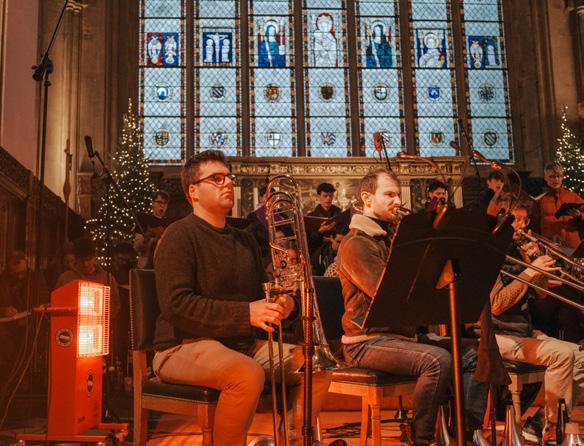
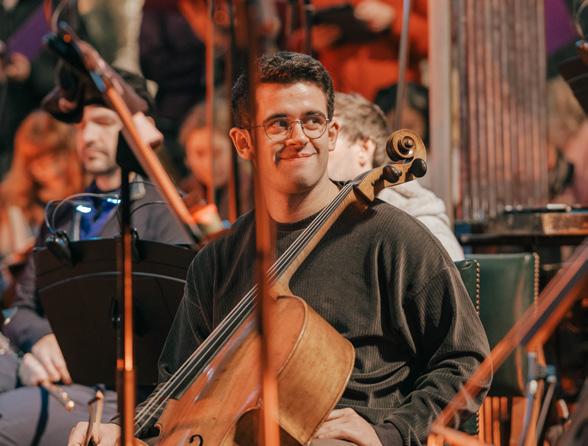
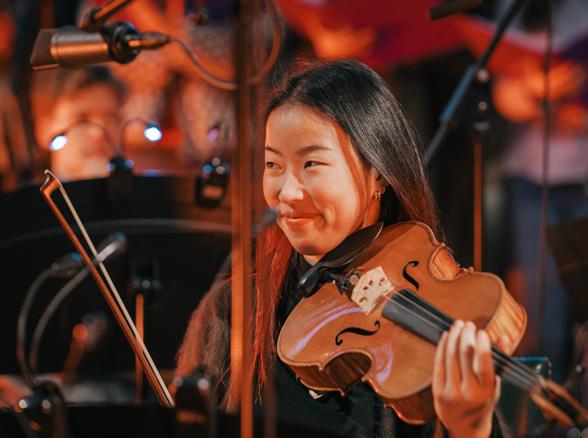
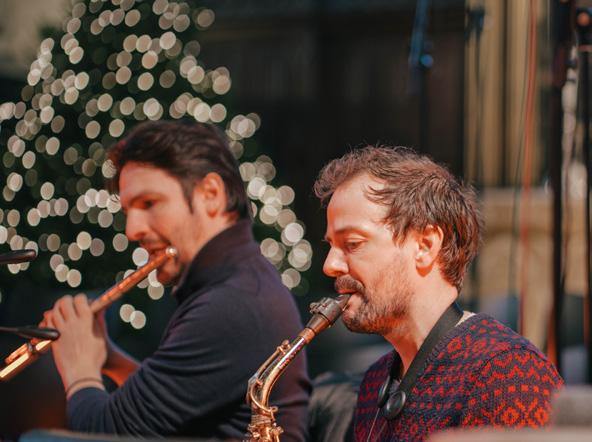
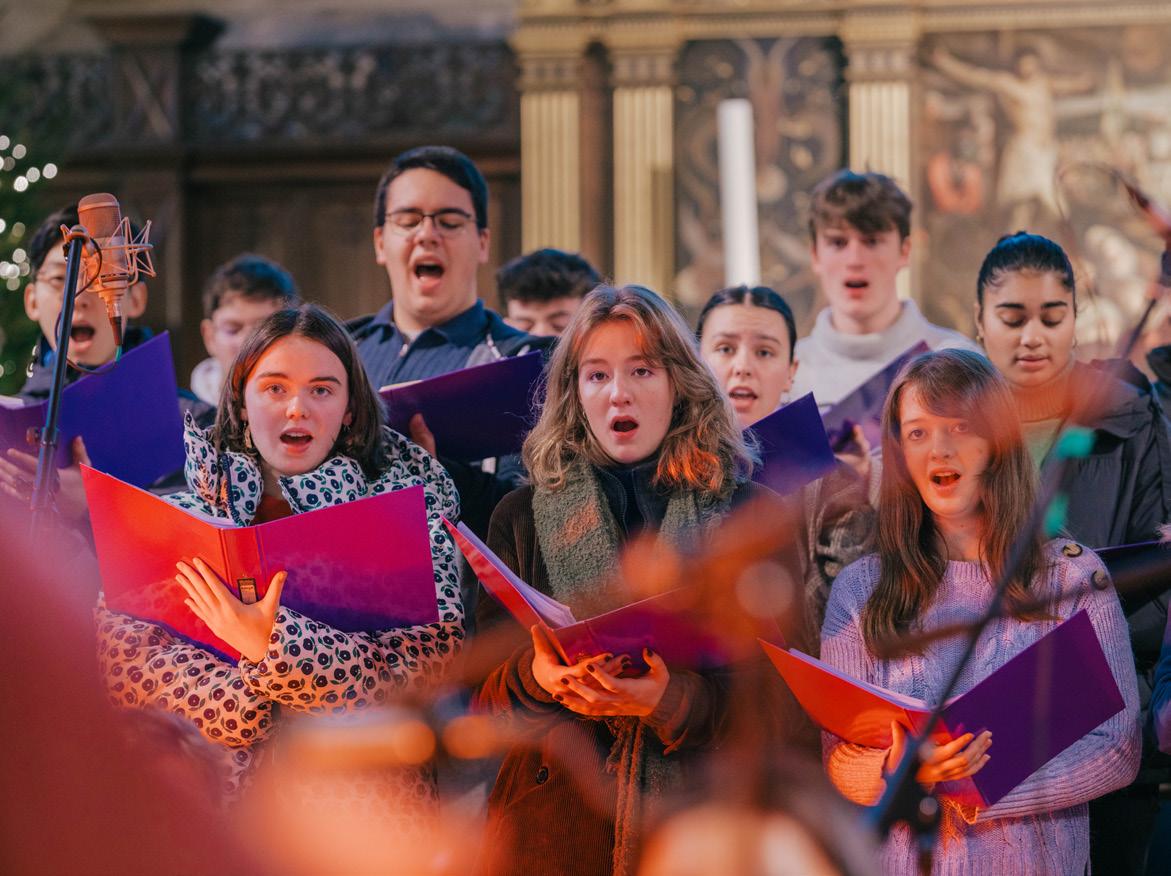
Acclaimed by Gramophone as ‘one of the UK’s finest choral ensembles’, the Choir of Merton College, Oxford is known as one of the most exciting university choirs in the UK. In addition to singing in the College’s thirteenth-century chapel during term, an extensive touring schedule has seen the choir perform in the USA, Hong Kong, Singapore, France, Germany, Italy, Denmark and Sweden, and in 2016 the choir sang the first Anglican service in St Peter’s Basilica, Rome, which was broadcast on BBC Radio 3.
The choir has performed with a number of major ensembles, including recent concerts with The King’s Singers, Britten Sinfonia and the Royal Philharmonic Orchestra. It has a long-standing recording relationship with Delphian Records; the choir’s recording of Gabriel Jackson’s The Passion of our Lord Jesus Christ (Delphian DCD34222) won the Choral category in the 2020 BBC Music Magazine Awards. Other recent recordings include two volumes of English choral music with Britten Sinfonia. In 2023 the choir made its debut at the Barbican, London, with a Good Friday performance of Bach’s St John Passion.
In 2016, Merton College became the first college of the University of Oxford to admit girls into its choral foundation. The 24 Girl Choristers of Merton College attend many different schools across Oxford and beyond, and rehearse at Merton on Mondays and Wednesdays during school term-time. Receiving specialist musical training from the College’s professional musicians, singing lessons and bursaries for instrumental instruction, they sing Choral Vespers each Monday and Choral Evensong each Wednesday during the University term, joined on Wednesdays by six professional adult singers who sing the lower parts.
In addition, the choristers undertake a number of concerts and other activities each year, including performing in the Passiontide at Merton festival and touring over the summer. Recent tours have seen them sing at Westminster Abbey, Gloucester Cathedral, Exeter Cathedral, Buckfast Abbey, Truro Cathedral, Durham Cathedral, Tewkesbury Abbey and Chichester Cathedral, as well as the Église Saint-Sulpice and the American Cathedral in Paris. The Choristers recorded their second album for Delphian Records in 2023.
Oxford Contemporary Sinfonia was founded by Benjamin Nicholas in 1998 while he was still an undergraduate. It is a flexibly constituted ensemble dedicated to the performance of new and recent music for choir and ensemble.
Premieres by the group include John
Caldwell’s Good Friday and Gabriel Jackson’s The Passion of our Lord Jesus Christ and The Christmas Story. The players of Oxford Contemporary Sinfonia are all experienced performers of new music and the line-up for the present recording includes members of the Kyan Quartet, Ensemble Bash and the trombone quartet Slide Action.
Benjamin Nicholas is Reed Rubin Organist & Director of Music at Merton College, Oxford and Music Director of the Oxford Bach Choir. He has held posts at Chichester and St Paul’s Cathedrals and was Director of the Edington Music Festival. As a conductor, he has appeared with the Philharmonia, the City of Birmingham Symphony Orchestra, Royal Philharmonic Orchestra and the BBC Singers, and has premiered works by numerous composers including Birtwistle, Dove, MacMillan, McDowall, Rutter and Weir.
Choir of Merton College,
Oxford
Soprano
Amy Higgins
Verity Sawbridge
Hattie Twigger-Ross
Maia Pereira
Amalia Wardle
Fran Geldard
Emma Arthur
Alice Fisher
Francesca Stevenson
Olivia Scarozza
Tatiana Fraser
Kira Lee
Ciara Williams
Alto
Naomi Richards
Antonia McClintock
Olivia Earl
LucyAnne Fletcher
Amelia Ross
Anneka Vetter
Harry Street
Alice Hilder Jarvis
Tenor
Wilkie Robson
Oscar Tovey Garcia
Henry Le Feber Robertson
Oliver Simpson
Conor Tidswell
Mark Wang
Clement Collins Rice
Benjamin Crossley
Bass
Hugo Till
Edward Chesterman
Katie Le Poidevin
Matthew O’Connor
Alexander Smith
Benedict Verdin
Nathaniel Otley
Freddy Chelsom
Tristan Wigley
Joseph Rhee
Senior Organ Scholar
Owen Chan
Junior Organ Scholar
François Cloete
Reed Rubin Director of Music
Benjamin Nicholas
The Girl Choristers of Merton College, Oxford
Clara Altebaumer
Maya Azad
Isabella Bandoja-Aravejo
Zoe Bingham
Raffi Bowen
Sayako Flossmann
Katerina Goeldner-Thompson
Margarita Harff
Rosie Howard
Miuccia Huang
Phoebe Hutt
Magdalena Kelly
Bea Newland
Bika Novruzzada
Lizzie Reynolds
Abigail Rolfe
Esther Samuel
Emilia Scaber
Zosia Scaber
Rhea Schenke-Gonis
Molly Templeton
Bessie Thomas
Helena Thomas
Clara Von Delft
Oxford Contemporary
Sinfonia
Flute
Pasha Mansurov
Alto Saxophone
Sam Corkin
Tenor Trombones
Jamie Tweed
Huw Llŷr Evans
Bass Trombone
Josh Cirtina
Percussion
Chris Brannick
Violin 1
Naomi Warburton
Violin 2
Sydney Grace Mariano
Viola
Wanshu Qiu
Cello
Hugh Mackay
Double Bass
Thea Sayer
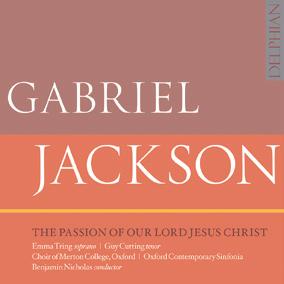
Gabriel Jackson: The Passion of our Lord Jesus Christ
Emma Tring soprano, Guy Cutting tenor, Choir of Merton College, Oxford; Oxford Contemporary Sinfonia / Benjamin Nicholas DCD34222
Strikingly coloured and richly imaginative, Gabriel Jackson’s re-telling of the age-old story of Christ’s betrayal and crucifixion interweaves biblical narrative, English poetry and Latin hymns, culminating in a rare setting of poetry by T.S. Eliot – himself an alumnus of Merton College, Oxford, which commissioned the present work. It is heard here under the direction of long-time Jackson collaborator Benjamin Nicholas, and with soloists and instrumentalists hand-picked by the composer.

‘This outstanding recording bursts with energy … Jackson’s engaging score is richly colourful and his instrumental writing proves a particular highlight’ — BBC Music Magazine, June 2019, CHORAL & SONG CHOICE
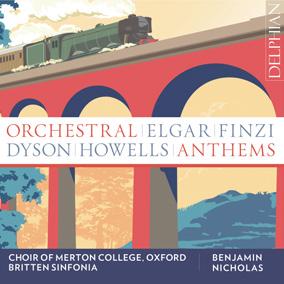
Orchestral Anthems: Dyson | Howells | Elgar | Finzi
Choir of Merton College, Oxford; Britten Sinfonia / Benjamin Nicholas DCD34291
For the Choir of Merton College, Oxford’s first collaboration with Britten Sinfonia, Benjamin Nicholas has brought together a collection of sacred works from the first half of the twentieth century. A littleknown fact is that these stalwarts of the English repertory were either originally intended to be heard with orchestra, or subsequently orchestrated by their composer or a close colleague. Written for enthronements, coronations and the nation’s grandest choral festivals, these national ‘standards’ are here brought back to life in Delphian’s largest recording to date, their orchestral accompaniments affording them the richness, pomp and majesty associated with their epoch.
‘Nicholas maintains excellent control of his forces in a recording that is sonorously generous and forward in sound … Britten Sinfonia play a colourful and sensitive role’ — Gramophone, August 2023
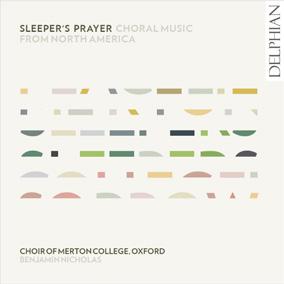
Sleeper’s Prayer: choral music from North America
Choir of Merton College, Oxford; Merton Brass / Benjamin Nicholas
DCD34232
The austere postminimalism of David Lang, in three pieces informed by elements of Jewish liturgy and thought, provides a striking foil to Nico Muhly’s more richly referential approach, that draws on his lifelong love of the Anglican tradition. Two solo organ works by Muhly and a transcription from his mentor Philip Glass’s opera Satyagraha are set in context alongside the more stylistically eclectic yet no less powerfully communicative sound-worlds of Libby Larsen and Abbie Betinis.
‘Merton’s new choral foundation aimed to combine tradition with bold innovation, and they pull that off here with some daring … The choir are in great voice, and Merton Brass could dep for the angels’ — Choir & Organ, May 2020
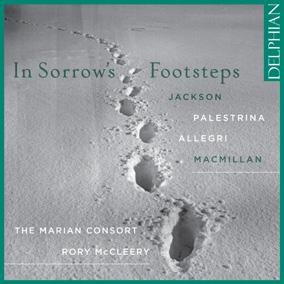

In Sorrow’s Footsteps: Jackson | Palestrina | Allegri | MacMillan
The Marian Consort / Rory McCleery
DCD34215
The Marian Consort plays to its twin strengths in a lovingly conceived programme coupling two pillars of Renaissance polyphony with twenty-first-century settings of the same texts, including a newly commissioned Stabat Mater by Gabriel Jackson. A range of subplots – Palestrina’s influence on Wagner, Charles Burney’s collecting of Allegri and Palestrina – make this truly a story of interconnections: a path on which the present’s footsteps constantly overlay the past’s. At the centre is Allegri’s Miserere, whose convoluted reception history itself becomes part of the story and whose performance here fully exploits the world-famous acoustic of Merton College’s chapel.
‘The ten singers buy fully into Jackson’s immersive setting, their interactions at times possessing the immediacy of chamber opera’ — BBC Music Magazine, August 2018
